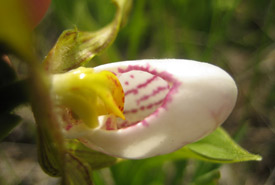
Small white lady's-slipper (Photo by Melissa Grantham)
Small white lady's-slipper
What does it look like?
The small white lady’s-slipper is a perennial orchid. It survives year after year as an underground stem. The plant can grow between 10 to 35 centimetres in height. A single plant can have between three and 60 stems.
Each stem is surrounded by two to four leaves and ends in a pouch-shaped flower. The flowers, which bloom in late May and June, are white with purple streaks and resemble slippers. Each flower also has two greenish-yellow twisted side petals that can have purple streaks or spots.
Fruit capsules appear in June and July, opening up between August and October to release thousands of small seeds that are later spread by the wind.
Where is it found?
The small white lady’s-slipper grows in southern Ontario and New York State, west to southern Manitoba and south through the American Midwest to Missouri and Kentucky.
In Ontario, the plant has disappeared from Norfolk, Kent, Bruce and Welland counties. Some populations still occur in Hastings and Lambton counties. Ontario populations occur in prairies, savannahs and fens (rich limestone wetlands).
In Manitoba, the plant is mainly found in the Tall Grass Prairie Preserve, the southern Interlake region and near the city of Brandon. Manitoba populations are found in calcium-rich prairie openings in wooded grasslands, open slopes that face south, undisturbed grassland and roadside ditches.
The small white lady’s-slipper once occurred in Saskatchewan, but has not been recorded there since 1895.
How does it reproduce?
Small white lady’s-slipper reproduces sexually through deceptive pollination and asexually via underground rhizomes. The plant’s seeds require a specific type of soil fungus to germinate.
What is its conservation status?
Under the Ontario and Manitoba Endangered Species Acts, and Canada’s federal Species At Risk Act, the small white lady’s-slipper is endangered. The Committee on the Status of Endangered Wildlife in Canada recently down-listed the plant from endangered to threatened. Globally, however, it is secure, according to the Association for Biodiversity Information.
What threatens this species?
Habitat loss and degradation from development are this species’ main threats. Additional threats include competition from invading species, such as leafy spurge and St. John’s wort. Illegal gathering, wildfire control, late spring frosts, herbicides and ditch clearing also pose threats to the species.
What is NCC doing to protect this species?
In Manitoba, most small white lady’s-slipper populations on NCC properties are located at the Tall Grass Prairie Preserve. To protect these populations, NCC staff in Manitoba have developed Multiple Species at Risk Recovery, Management and Research (Multi-SAR) plans. These are used for planning, managing NCC properties where the species occurs, effectiveness monitoring, land stewardship decision-making and developing a list of key research requirements. Through collaboration with research partners, many projects have been carried out at the preserve to study various aspects of small white lady’s-slipper biology.
NCC staff in Manitoba use land management practices, such as prescribed fire, which benefit the species. They also conduct annual monitoring of Tall Grass Prairie Preserve populations with preserve partners. They are currently working on a project to study the potential relationships between Tall Grass Prairie Preserve populations and weather and land management, using 18 years of small white lady’s-slipper monitoring data. Finally, they have conducted surveys to find new small white lady’s-slipper populations on some of NCC’s Interlake properties.





